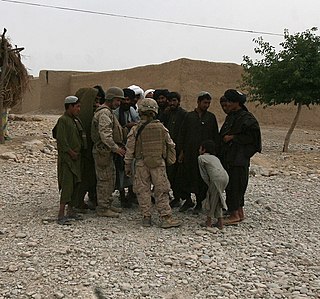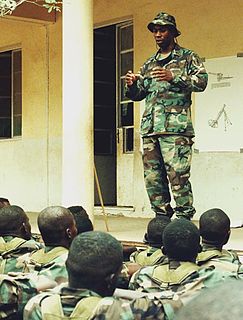Related Research Articles

A strategy game or strategic game is a game in which the players' uncoerced, and often autonomous, decision-making skills have a high significance in determining the outcome. Almost all strategy games require internal decision tree-style thinking, and typically very high situational awareness.
Military science is the study of military processes, institutions, and behavior, along with the study of warfare, and the theory and application of organized coercive force. It is mainly focused on theory, method, and practice of producing military capability in a manner consistent with national defense policy. Military science serves to identify the strategic, political, economic, psychological, social, operational, technological, and tactical elements necessary to sustain relative advantage of military force; and to increase the likelihood and favorable outcomes of victory in peace or during a war. Military scientists include theorists, researchers, experimental scientists, applied scientists, designers, engineers, test technicians, and other military personnel.
Military strategy is a set of ideas implemented by military organizations to pursue desired strategic goals. Derived from the Greek word strategos, the term strategy, when it appeared in use during the 18th century, was seen in its narrow sense as the "art of the general", or "'the art of arrangement" of troops. Military strategy deals with the planning and conduct of campaigns, the movement and disposition of forces, and the deception of the enemy.

A military, also known collectively as armed forces, is a heavily armed, highly organized force primarily intended for warfare. It is typically authorized and maintained by a sovereign state, with its members identifiable by their distinct military uniform. It may consist of one or more military branches such as an army, navy, air force, space force, marines, or coast guard. The main task of the military is usually defined as defence of the state and its interests against external armed threats.
Military doctrine is the expression of how military forces contribute to campaigns, major operations, battles, and engagements.

Military intelligence is a military discipline that uses information collection and analysis approaches to provide guidance and direction to assist commanders in their decisions. This aim is achieved by providing an assessment of data from a range of sources, directed towards the commanders' mission requirements or responding to questions as part of operational or campaign planning. To provide an analysis, the commander's information requirements are first identified, which are then incorporated into intelligence collection, analysis, and dissemination.

Unconventional warfare (UW) is the support of a foreign insurgency or resistance movement against its government or an occupying power. Whereas conventional warfare is used to reduce the opponent's military capability directly through attacks and maneuvers, unconventional warfare is an attempt to achieve victory indirectly through a proxy force. Unconventional contrasts with conventional warfare in that forces are often covert or not well-defined, and subversion and guerrilla warfare are relied upon.
A military operation is the coordinated military actions of a state, or a non-state actor, in response to a developing situation. These actions are designed as a military plan to resolve the situation in the state or actor's favor. Operations may be of a combat or non-combat nature and may be referred to by a code name for the purpose of national security. Military operations are often known for their more generally accepted common usage names than their actual operational objectives.

Counterinsurgency (COIN) is "the totality of actions aimed at defeating irregular forces". The Oxford English Dictionary defines counterinsurgency as any "military or political action taken against the activities of guerrillas or revolutionaries" and can be considered war by a state against a non-state adversary. Insurgency and counterinsurgency campaigns have been waged since ancient history. However, modern thinking on counterinsurgency was developed during decolonization. Within the military sciences, counterinsurgency is one of the main operational approaches of irregular warfare.
A military campaign is large-scale long-duration significant military strategy plan incorporating a series of interrelated military operations or battles forming a distinct part of a larger conflict often called a war. The term derives from the plain of Campania, a place of annual wartime operations by the armies of the Roman Republic.
Principles of war are rules and guidelines that represent truths in the practice of war and military operations.
Deep operation, also known as Soviet Deep Battle, was a military theory developed by the Soviet Union for its armed forces during the 1920s and 1930s. It was a tenet that emphasized destroying, suppressing or disorganizing enemy forces not only at the line of contact but also throughout the depth of the battlefield.
Effects-based operations (EBO) is a United States military concept that emerged during the Persian Gulf War for the planning and conduct of operations combining military and non-military methods to achieve a particular effect. An effects-based approach to operations was first applied in modern times in the design and execution of the Desert Storm air campaign of 1991. The principal author of the daily attack plans—then Lt Colonel, now retired Lt General David A. Deptula—used an effects-based approach in building the actual Desert Storm air campaign targeting plan. Deptula describes the background, rationale, and provides an example of how an effects-based approach to targeting was conducted in Desert Storm in the publication, "Effects-Based Operations: Change in the Nature of Warfare." The doctrine was developed with an aim of putting desired strategic effects first and then planning from the desired strategic objective back to the possible tactical level actions that could be taken to achieve the desired effect. Contrary to conventional military approaches of force-on-force application that focused on attrition and annihilation, EBO focused on desired outcomes attempting to use a minimum of force. The approach was enabled by advancements in weaponry—particularly stealth and precision weapons—in conjunction with a planning approach based on specific effects rather than absolute destruction. Deptula, speaking at the Gulf War Air Campaign Tenth Anniversary Retrospective, on 17 January 2001 on One Massachusetts Avenue, NW, Washington, DC, defined the goal of EBO; "If we focus on effects, the end of strategy, rather than force-on-force the traditional means to achieve it militarily, that enables us to consider different and perhaps more effective ways to accomplish the same goal quicker than in the past, with fewer resources and most importantly with fewer casualties." Others have postulated that EBO could be interpreted as an emerging understanding that attacking a second-order target may have first order consequences for a variety of objectives, wherein the Commander's intent can be satisfied with a minimum of collateral damage or risk to his own forces.

Foreign internal defense (FID) is a term used by the militaries of some countries, including the United States, France, and the United Kingdom, to describe an integrated and synchronized, multi-disciplinary approach to combating actual or threatened insurgency in a foreign state. This foreign state is known as the Host Nation (HN) under the US doctrine. The term counter-insurgency is more commonly used worldwide than FID.
An offensive is a military operation that seeks through an aggressive projection of armed forces to occupy territory, gain an objective or achieve some larger strategic, operational, or tactical goal. Another term for an offensive often used by the media is "invasion", or the more general "attack". An offensive is a conduct of combat operations that seek to achieve only some of the objectives of the strategy being pursued in the theatre as a whole. Commonly an offensive is carried out by one or more divisions, numbering between 10 and 30,000 troops as part of a combined arms manoeuvre.
Strategic defence is a type of military planning doctrine and a set defense and/or combat activities used for the purpose of deterring, resisting and repelling a strategic offensive, conducted as either a territorial or airspace, invasion or attack; or as part of a cyberspace attack in cyberwarfare; or a naval offensive to interrupt shipping lane traffic as a form of economic warfare.
Military capability is defined by the Australian Defence Force as "the ability to achieve a desired effect in a specific operating environment". It is defined by three interdependent factors: combat readiness, sustainable capability and force structure.
Hybrid warfare is a theory of military strategy, first proposed by Frank Hoffman, which employs political warfare and blends conventional warfare, irregular warfare, and cyberwarfare with other influencing methods, such as fake news, diplomacy, lawfare and foreign electoral intervention. By combining kinetic operations with subversive efforts, the aggressor intends to avoid attribution or retribution. The concept of hybrid warfare has been criticized by a number of academics and practitioners due to its alleged vagueness, its disputed constitutive elements, and its alleged historical distortions.

Combat effectiveness is the capacity or performance of a military force to succeed in undertaking an operation, mission or objective. Determining optimal combat effectiveness is crucial in the armed forces, whether they are deployed on land, air or sea. Combat effectiveness is an aspect of military effectiveness and can be attributed to the strength of combat support including the quality and quantity of logistics, weapons and equipment as well as military tactics, the psychological states of soldiers, level of influence of leaders, skill and motivation that can arise from nationalism to survival are all capable of contributing to success on the battlefield.